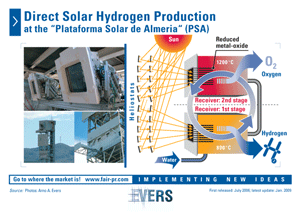Arno's EnergyIdeas (30)
Direct solar hydrogen: Quo vadis?
Most of what is called "environmentally friendly hydrogen technology", is currently coming from fossil fuels, mainly produced by reforming of natural gas. This hydrogen is not at all CO2 free, and certainly not renewable. Nevertheless, many (from media, politics and administration) are creating the impression that everything that is converted in a fuel cell into electricity (and heat and water) is: "100 percent clean, 100 percent steam". On closer examination of the origin of hydrogen, this is not the case, anywhere in the world. Hydrogen t this time is generated 95 percent from fossil fuels, manly from coal and natural gas. The remaining 5 percent of the hydrogen is produced through electrolysis, made from electricity, which is indefinable produced and transmitted. Actually, it is not worthwhile to follow this aberration any further.

Photo / Illustration: Direct solar hydrogen production, graphic design: Thomas Schirmaier, Arno A. Evers FAIR-PR |
This is really a pity, and we should actively and purposeful keep more emphasis to make hydrogen in a new process in a „one shot manufacturing step“ only. I had the chance to see one solution of the direct solar production of hydrogen, which is working now, at the "Plataforma Solar de Almeria“ (PSA) in Southern Spain.
The German Aerospace Center (DLR) was already active in the founding of this unique research facility in year 1980. DLR works until today, together with European partners, in exploring the direct use of solar energy. This includes photovoltaic and solar thermal. Prof Carl-Jochen Winter, who is writing his column for this newsletter every 14 days with me in exchange, has signed the cornerstone for the establishment, as the SSPS Operating Agent, among the Spanish Minstro de Industria y Energia and the IEA Executive Director, at January 17, 1980. A pioneering step, which until today continues by many active European scientists, researchers and technichians.
In several research and development projects, over the years, various concepts from the laboratory processes to pilot-scale preparation have been created. In the long term, hydrogen can only be produced from raw materials, which are free of carbon. These raw materials are water and sunlight. The direct solar hydrogen production used in thermal processes do not need any coal, natural gas or oil. Additionally, it also simply saves the step to converte energy from heat into electricity and the high flaring and transmission losses within the existing electricity system.
Already since the 1970s, German DLR is engaged successfully in thermochemical cycle processes in which water is split by means of several steps. To achieve this, one or more reactants in the process are recovered and recycled. Several hundred of these procedures are documented and are currently sporadic appearing as "breaking news" messages in the media. There are two groups: one uses inorganic sulfur compounds, such as sulfuric acid, the other method is based on metals or metal oxides, especially iron.
The DLR is also working on iron based thermochemical cycle processes. Here the reactive material - based on iron oxide - is rotatory oxidized and reduced again. A with this material coated ceramic cylinder, which features many parallel channels and bears resemblance to an auto exhaust catalyst, is heated in a solar receiver-reactor with concentrated solar radiation to about 800 degrees celsius. The water vapor reacts with the coating, whereupon oxygen is bounded and hydrogen is released. In a second reaction step, the water vapor is turned off and the receiver-reactor is heated up to about 1,200 degrees celsius. Thereby the oxygen on the reactive coating escapes and the cycle begins again (see our chart).
This procedure has had, after initial pilot tests of the Institute of Technical Thermodynamics at the DLR in Germany, its sucessfull dress rehearsal in November 2008 on the Spanish Plataforma Solar de Almeria. The two solar receiver-reactors are mounted in 28 meters high on the so-called SSPS Tower (Small Solar Power System). The units are installed in modular mode, currently designed for 100 kW. The structure is relatively unspectacular, the two reactors have the size of a normal household refrigerator. The already installed sun heliostats (mirrors), automatically tracking the sun, have a thermal capacity of max. 2.7 MW. The location in Tabernas, with over 3,000 hours of sunshine per year and a direct solar radiation of 1.900 kW / h per square meter provide to have Europe's best solar power.
The tests in the PSA are now continoued. It's all about optimizing the operating conditions and improve the efficiency of the installation. Additional tests with coated solar absorbers will identify even better suitable materials.
Congratulations to the participating researchers and engineers at DLR and all their European partners on this project. However, one should keep in mind: A nationwide introduction of this procedure, with the hydrogen as a fuel for distributed generation of electricity, heat and water as well as provision of transport service will provide a truly renewable and emission-free future. However, this step requires a rethinking within todays energy system and procedures There must be a transition from the now real "electritcity, gas and oil industry" with eg 1,000,000 kilometers of low-voltage network length and 557,700 Medium Voltage Transformers in Germany alone.
For my understanding. the resistance at this time is more in the heads than the problems in the technology. They are big, however, but both can be overcome. This major change will, however, not come on its own. One must, except to overcome the technical requirements, also work on the dissemination of true information about the existing advantages, opportunities and possibilities. Whether, however, scientists, researchers and technicians can manage this challenge alone? ... This question should be allowed at this point.
Photo / Illustration: Direct solar hydrogen production, graphic design: Thomas Schirmaier, Arno A. Evers FAIR-PR
Links to the news:
http://www.psa.es/
http://www.dlr.de/en/desktopdefault.aspx/tabid-667/7411_read-14380/
https://www.hydrogenambassadors.com/aae/plataforma-solar-almeria/
https://www.hydrogenambassadors.com/background/facts.php#h2fromdirectsolar
https://www.hydrogenambassadors.com/background/german-high-voltage-network.php
Date: 10.02.2009 |
